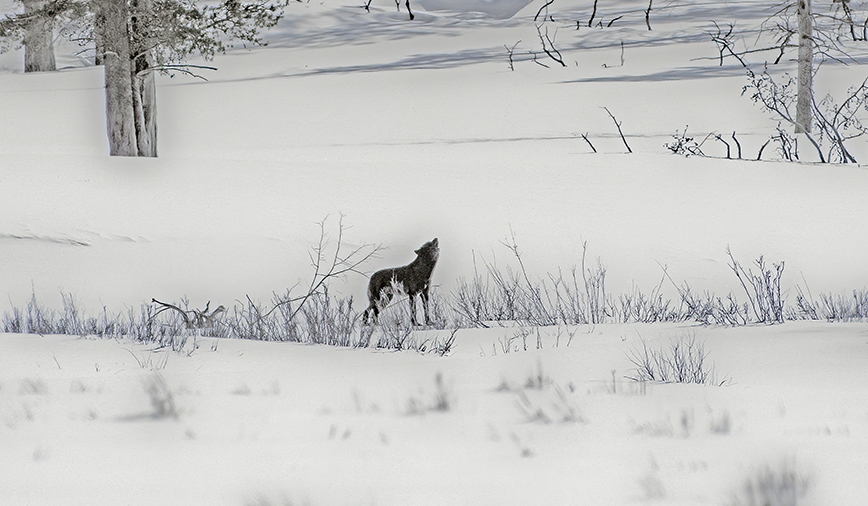April 4, 2014
Photo Provided by Trudy Heinlein
Coyotes
“Ewe’s not fat, ewe’s just fluffy!”
This statement, a supportive slogan for snackers everywhere, made me laugh out loud the first time I saw it on a neighbor’s refrigerator magnet. I could practically hear the sheep pictured there cheering me on as I reached for another helping of my friend’s chips and dip.
Those words have since become a source of reassurance whenever I’ve faced an abundance of flab. I mean fluff.
Pants too tight? Naw, you’s not fat. Shirt can’t cover the “muffin top?” No worries, you’s just fluffy.
To my delight (and perhaps others’ chagrin) I have yet to encounter a situation where I can’t apply the claim. Friends, relatives, coworkers…none are safe from this endlessly amusing pun.
And now, I’ve found, it’s even more true for coyotes.
This past winter being what it was—cold, snowy and all-around unforgiving—coyotes were out and about, likely more than usual. Over the course of three or four months, residents throughout the area called or emailed to relate their sightings. And, more often than not, also express their concern over the animals’ seemingly large size.
“This guy was really big,” was a frequent comment. “It looked like a wolf,” was another.
The phone calls spiked in late January, prompting me to write a column about the likelihood of wolves in Illinois. The gist of the piece was, while not impossible, the likelihood of spotting a wolf in our area is very low.
Then, right about that same time, the PBS show Nature aired an episode titled “Meet the Coywolf.” (If you have an opportunity, check it out at www.pbs.org. It may also air again on one of WTTW’s digital channels. I don’t have cable, but ran into the show again the other night while surfing through the channels my rabbit ears provide.)
The program, which described coyotes whose genetic makeup includes a dash of wolf, is compelling enough that I may devote a future column to the information it conveyed. But for the time being, let’s just focus on the impression it left with local viewers.
Between January 22nd, its original air date, and mid-March, I must have heard from 50 people saying they saw a coywolf in their yard/neighborhood/local park. Coywolves in St. Charles. Coywolves in Batavia. Coywolves in Elgin.
With each subsequent message, I wondered all the more, “Why the heck have I never heard of these guys?”
Curious to learn more about this new critter that, as the documentary reported, “is moving through the landscape of North America at a startling pace,” I contacted Heidi Garbe, a local research biologist intimately familiar with the Chicago region’s urban—and suburban—coyotes.
Heidi was one of the researchers shown in the Chicago segment of “Meet the Coywolf,” and also was one of the experts who participated in a panel discussion on coyotes that we hosted at Hickory Knolls last fall. As someone who has tracked our local radio-collared coyotes, examined their pups and analyzed their blood samples, she knows these animals—literally—inside and out.
As Heidi explained to me via email, many ecologists seem to argue the term coywolf. “The coyotes up in eastern Canada are eastern coyotes, which have a tiny bit of wolf gene but size-wise, you could not differentiate them from our guys (by weight),” she wrote.
“Even if ‘coywolves’ did show up here, the difference would not be significant to the public because they are not that different from western coyotes. Some of the animals highlighted in the show may not have been typical of the population as a whole (i.e. the larger skull size) and instead were random examples.”
Heidi did note that the ongoing Chicago-area study (described in detail at http://urbancoyoteresearch.com) has not looked extensively at the presence of wolf genes in genetic samples. “But if abnormal (wolf) genes were present we would notice,” she said. “Here we have
western coyotes and to date, have had no genes to show that there is a wolf influence in any of our processed genetic samples taken from any of our study animals.”
So what’s the deal with all the wolfy-like animals people reported this winter?
“Often times a very healthy coyote will have a huge, bushy coat that could make it resemble something more like a wolf,” Heidi said. “I have seen a few huge coyotes from which we were able to get biometric data. It always amazed me that they weighed less than they looked. From a distance especially, looks can be deceiving.”
With spring in the air, sort of, our local coyotes will be shedding their thick winter pelage. I suspect that reports of wolf or coywolf-like animals will be dropping too. But over these next few weeks, try to remember Heidi’s wise words should you happen to catch a glimpse of any large, wild canines.
I hope she’ll forgive me if I paraphrase: They’re not fat. They’re just fluffy.
Pam Otto is the manager of nature programs and interpretive services at the Hickory Knolls Discovery Center, a facility of the St. Charles Park District. She can be reached at 630-513-4346 or potto@stcparks.org.

